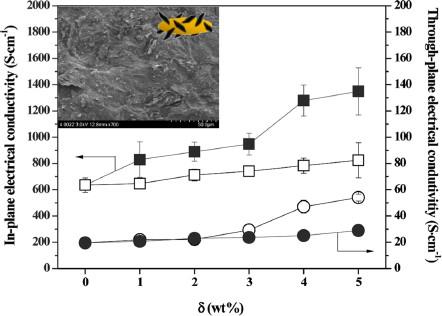Macromolecular Research ( IF 2.8 ) Pub Date : 2020-08-18 , DOI: 10.1007/s13233-020-8140-y Sang-Ha Kim , Jong Seok Woo , Soo-Young Park

|
Graphite nanoplatelets (GNPs) have been used as a secondary filler to improve the electrical conductivity of poly(phenylene sulfide) (PPS)/graphite composites for use as bipolar plates in fuel cells, and the effects of adding small quantities of GNPs on the electrical, thermal, and mechanical properties of PPS/GNP/graphite composites have been extensively studied. The GNPs were compounded with PPS to produce master batch (MB) chips that were further ground to fine MB powder (MBg). PPS/MBg/graphite powders were compressed to fabricate 10-mm thick square samples. Composites containing a large quantity of graphite (~80 wt%) were then tested for use as a bipolar plate in phosphoric acid fuel cells. When 5 wt% GNP was added to the PPS/graphite composite, the in-plane electrical conductivity increased almost twofold from 643 to 1340 S·cm−1, the through-plane electrical conductivity increased from 19 to 54 S·cm−1, the through-plane thermal conductivity increased approximately two-fold from 60 to 129 W·(mK)−1, and the flexural strength decreased slightly from 32 to 26 MPa. The fractured surface of the compressed MBg sample revealed well-dispersed GNPs in the PPS matrix, which created electrical pathways and improved the electrical conductivity of the non-conducting PPS matrix material. Thus, the PPS/GNP/graphite composite is a promising system for bipolar plate applications because a higher amount of graphite (~93 wt%) is needed in PPS/graphite composites to reach the same level of electrical conductivity as the PPS/MBg(5 wt%)/graphite (75 wt%) composite, and such a large quantity of graphite is difficult to process and leads to weaker mechanical properties.
中文翻译:

石墨纳米片作为燃料电池应用中双极板的次要填料的聚苯硫醚石墨复合材料
石墨纳米片(GNP)已被用作辅助填料,以改善用作燃料电池中双极板的聚苯硫醚(PPS)/石墨复合材料的电导率,以及在电气上添加少量GNP的影响对PPS / GNP /石墨复合材料的热,机械性能进行了广泛的研究。将GNP与PPS混合以生产母料(MB)碎片,然后将其进一步研磨成MB细粉(MB g)。PPS / MB克将石墨粉压缩以制造10毫米厚的正方形样品。然后测试了包含大量石墨(〜80 wt%)的复合材料,用作磷酸燃料电池中的双极板。当向PPS /石墨复合物中添加5 wt%GNP时,面内电导率从643增加到两倍,达到1340 S·cm -1,通面电导率从19增加到54 S·cm -1,贯穿面的热导率从60到129 W·(mK)-1增加了大约两倍,抗弯强度从32 MPa略有降低。压缩后的MB g的断裂面样品显示PPS基质中的GNP分散良好,这创造了电通路并提高了非导电PPS基质材料的电导率。因此,PPS / GNP /石墨复合材料是用于双极板应用的有前途的系统,因为在PPS /石墨复合材料中需要更高数量的石墨(〜93 wt%)才能达到与PPS / MB g相同的电导率水平。(5重量%)/石墨(75重量%)复合材料,并且如此大量的石墨难以加工并且导致较弱的机械性能。











































 京公网安备 11010802027423号
京公网安备 11010802027423号